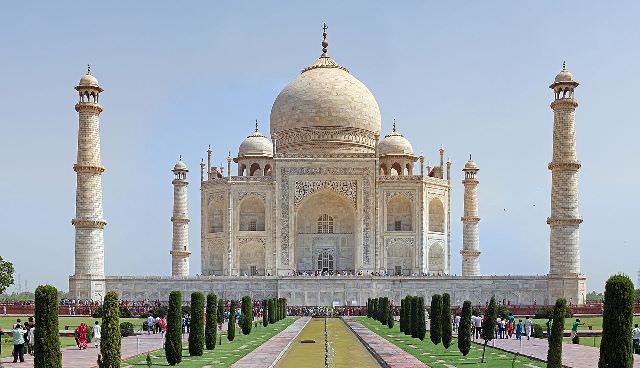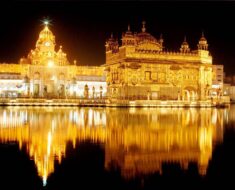Taj Mahal is not only an immense mausoleum of white marble but an absolute symbol of Love and affection.
It is located on the right bank of the Yamuna River in a vast Mughal garden that encompasses nearly 17 hectares, in the Agra District in Uttar Pradesh.
It is the greatest architectural achievement of the Mughal period. Here is a list of facts about the Taj Mahal, one of the seven wonders of the world.
Fact #1 Shah Jahan and Mumtaz Mahal

Taj Mahal – the Symbol of love was built by Mughal emperor Shah Jahan in the loving memory of his beloved wife Mumtaz Mahal. She was Shah Jahan’s fourth wife and he was madly in love with her.
Mumtaz Mahal’s real name was Arjumand Banu Begum.
Shah Jahan gave her the title of Mumtaz Mahal meaning “the chosen one of the palace”
Mumtaz Mahal died when she was giving birth to their fourteenth child at the age of 37 due to excessive blood loss. She remained in painful labor for 30 hours before she died.
Shah Jahan at her deathbed promised her that he would build her a magnificent tomb world has never seen.
She was initially buried in Burhanpur in 1631 AD, in a walled garden called Zainabad.
Her body was later exhumed and transported in a gold casket back to Agra and buried in a small building on the banks of river Yamuna.
Shah Jahan was so shattered by the sad demise of her dearest wife Mumtaz Mahal that he isolated himself from everything and kept on mourning for almost a year.
His daughter Jahanara Begum gradually brought him out of distress and when he came back, all his hair had turned white and his face looked too old.
Fact #2 Architecture of the Taj Mahal

Taj Mahal means Crown of Palaces and it is not a just masterpiece of architecture; it is a wonder of wonders in the world.
In Badshahnama (History of Shah Jahan reign), the Taj Mahal is called rauza-i munawwara which means illustrious tomb.
Ustad Ahmed Lahauri an Indian of Persian descent was the chief architect of the Taj Mahal.
Its architecture is a blend of Mughal, Persian, Ottoman Turkish, and Indian architectural styles.
The tomb is the main attraction and focus of the entire complex of the Taj Mahal.
The tomb is surrounded by four smaller domes and four minarets at the corner.
Minarets are constructed slightly outside of the plinth so that they will fall away from the tomb in case of an earthquake or any natural calamity.
Verses from Quran were inscribed in calligraphy throughout the complex.
The calligraphy on the entrance gate reads, “O Soul, thou art at rest. Return to the Lord at peace with Him, and He at peace with you.”
Inside the mausoleum, there is a false tomb of Mumtaz Mahal and Shah Jahan in an octagonal marble chamber.
As per Islamic traditions, it is prohibited to decorate graves. That is why the last remains of Mumtaz Mahal and Shah Jahan were kept in a plain crypt under the chamber with their faces turned towards Mecca.
💡 Read More: 15 Must-Visit Historical Places in India
Facts #3 Construction of the Taj Mahal

In 1632, the construction of the Taj Mahal was started and it is believed that the entire complex was completely built in 1653.
The plinth and Mausoleum took almost 12 years to complete and it took almost another 10 years to complete minarets, mosques, and gateway.
To construct the Taj Mahal, building materials were brought from all parts of India and Asia.
Marble was brought from Makrana, Rajasthan. 28 types of different precious and semi-precious stones were inlaid in the white marble.
The jasper came from Punjab, jade and crystal were from China, the turquoise from Tibet, the Lapis lazuli from Afghanistan, the sapphire from Sri Lanka, and the carnelian from Arabia.
To transport construction material 1000 elephants were used. 20,000 artisans, craftsmen, and labourers were employed to build this magnificent mausoleum.
It is estimated that 32 million Indian rupees were spent to construct the Taj Mahal, which would be approximately 52.8 billion rupees (US$827 million)
Fact #4 Damaged during wars

The Taj Mahal was badly damaged and looted during the early 18th century by the Jat rulers of Bharatpur. Raja Ram Jat invaded Agra and plundered Akbar’s tomb and Taj Mahal.
They ransacked and looted gold, jewels, and precious stones, and destroyed other things to avenge the death of his father Gokula.
During the first War of Indian Independence in 1857, it was again badly vandalized and defaced by British soldiers. They chiselled out precious and semi-precious stones from the walls of the Taj Mahal.
Lord Curzon ordered the much-needed restoration of the Taj Mahal which had lost its glory and grandeur during these attacks and wars.
Taj Mahal’s lush green gardens were also remodelled as per British-style lawns. He also installed a large lamp in the inner chamber, modelled after the Cairo mosque.
Read More: Qutub Minar – Tallest Brick Minar in the World
Fact #5 Myths about the Taj Mahal

There are several myths about the Taj Mahal and one of the most common is that Shah Jahan copped off the hands of the architects, craftsmen, and workers, after its completion.
So that they couldn’t make a similar building. No evidence of such stories or claims has been found.
There is also another story that claims that Shah Jahan planned to build a black Taj Mahal across the Yamuna River.
But again this story has no evidence and such an idea originated from the imaginative stories of Jean-Baptiste Tavernier. He was a European writer who visited Agra in 1665.
There is another myth that says that Lord William Bentinck in the 1830s planned to demolish it and auction its marble.
This story was probably generated from Lord Bentick’s fundraising sale of discarded marble from Agra fort.
Read More: Golden Temple, Amritsar – Four Doors To Heaven
Fact #6 Wars
During the Second World War British government erected scaffoldings and false structures around the Taj Mahal to mislead the German and Japanese Air Force attack.
Similar false structures were erected by the Indian government during the 1965 and 1971 wars against Pakistan.
Fact #7 Different moods

The Taj Mahal is a spectacular piece of artwork and a symbol of love and affection.
You will be amazed to know that it changes different colours during the different times of the day, from pink in the morning, to milky in the evening and golden at night under the moon.
It is said that changing colours bear a resemblance to the changing moods of a female in particular Mumtaz Mahal.
Read More: Statue of Unity – Tallest Statue in the World
Facts #8 Replicas of the Taj Mahal

The Taj Mahal is an iconic architectural masterpiece that has inspired many replicas in India and around the world.
Bibi ka Maqbara (Tomb of the Lady) built by Shah Jahan’s grandson Muhammad Azam Shah, in Aurangabad, Maharashtra resembles a lot with original Taj Mahal.
In fact, it is also called the Taj of the Deccan. He built it in memory of his mother Dilras Banu Begum.
Shahzadi Ka Maqbara, in Chota Imambara, is also a small-scale copy of the Taj Mahal. It is the tomb of Princess Zinat Algiya, daughter of King Mohammad Ali Shah Bahadur third king of Awadh.
A Bangladeshi filmmaker constructed a replica of the Taj Mahal in 2008 at a cost of US $56 million. It took five years to complete the replica with all modern equipment and technology.
China also has a replica of the Taj Mahal in the Window of the World theme park in Shenzhen.
Malaysia also has a Mini Taj Mahal in Legoland Malaysia Resort in Nusajaya, Johor.
Taj Arabia, a Taj Mahal-inspired luxury hotel and shopping complex is under construction in Dubai. It is said that it will be four times bigger than the size of the Taj Mahal and will cost an estimated US $1 billion.
Fact #9 P.N. Oak
P.N Oak an Indian writer claims that the Taj Mahal was originally a Shiva Temple and a Rajput Palace named Tejo Mahalaya.
In his book Taj Mahal: The True Story claims that Shah Jahan seized it and converted it into a tomb.
He appealed in court but the Supreme Court of India rejected his appeal to give credit for the construction of the Taj Mahal to 12th-century Hindu King Raja Parmar Dev.
Sociologist Amarnath Mishra also approached Allahabad High Court on the same grounds but his appeal was also rejected.
Several court cases were filed in 2017 about the Taj Mahal a Hindu temple inspired by P. N. Oak’s theory.
The Archaeological Survey of India (ASI) stated there was no evidence to suggest the monument ever housed a temple
Fact #10 Pollution’s ill effects on the Taj Mahal
Environmental pollution has caused a tremendous amount of damage to the Taj Mahal.
It is turning yellow day by day.
Acid rains due to the Mathura oil refinery, and pollution on the bank of river Yamuna are very serious concerns.
Moreover declining groundwater level of the Yamuna River basin is a very major concern as it could disturb and erode the foundation of the Taj Mahal.
It is declining at an alarming rate of 5 feet every year. Thus, raising concerns that the structure may crumble if the proper countermeasures are not taken soon.
The government of India has taken several measures the safeguard the Taj Mahal.
Polluting traffic is strictly prohibited from coming within 500 meters of the complex.
Tourists must walk from the parking lots or can take electric buses.
Moreover, the Taj Trapezium Zone is set up under which strict emission standards and regulations have been set around an area of 10,400 sq km around it.
On April 11, 2018, a storm damaged the small minarets located at two of the outlying buildings.
Another thunderstorm on 31 May 2020, caused some damage to the complex.
It is our priceless enduring legacy and it must be preserved at any cost.
Some more Interesting Facts about The Taj Mahal
- The other two wives of Shah Jahan and even his favourite servant were buried in the tomb outside of the Taj Mahal.
- Grammy Award winner Henry Saint Clair Fredericks uses the Taj Mahal as his stage name. He is an American blues musician, a self-taught singer-songwriter, and a film composer.
- PC Sarkar Jr. Famous Indian magician disappeared Taj Mahal for two minutes. He created a perfect optical illusion in front of a huge audience on 6 November 2000.
- In 1983, the Taj Mahal was nominated as a UNESCO World Heritage Site and is one of the seven wonders of the world
- The main gate of the Taj Mahal provides a very interesting optical illusion for the tourists, as one moves towards the Taj Mahal from the main gate, the main tomb appears to move away from you.
- Shah Jehan’s daughter Jahanara Begum asked for a simple grave covered over with grass only and refused to have a mausoleum like the Taj Mahal
- The Taj Mahal is taller than the Qutub Minar.
- A very amazing fact about the Taj Mahal is that it is taller than Qutab Minar. The height of the Taj Mahal is 73 meters while Qutab Minar is 72.5 meters only.
- Another bizarre fact about the Taj Mahal that is hard to believe but it really happened. Notorious Indian con man Natwar Lal sold the Taj Mahal three times to wealthy foreign tourists. He even sold the Red Fort, Rashtrapati Bhavan, and also the Parliament House of India along with its 545 sitting members.
- Shah Jahan was put under house arrest by his son, Aurangzeb in 1658. For the last eight years of his life, he was only able to view the Taj Mahal from his window.











